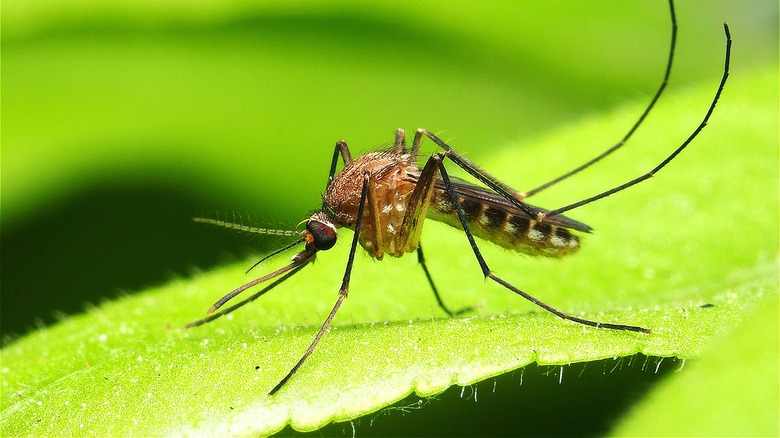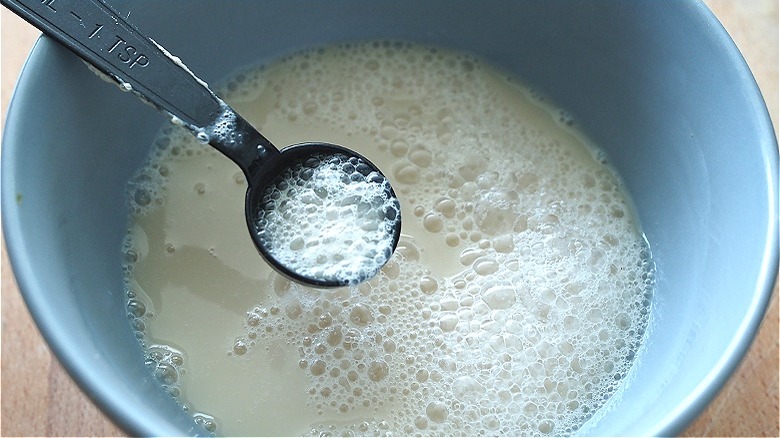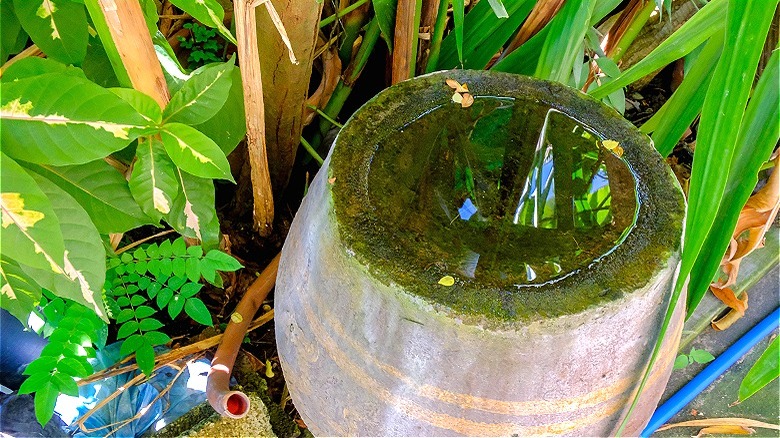Banish Mosquitoes From Your Yard With These Two Handy Baking Ingredients
You've eliminated all sources of standing water, pumped the brakes on outdoor buffets, and even stopped wearing dark clothes while working in the garden. Yet, your yard is still a mecca for mosquitos. Hiring a professional to eliminate the flying pests is an option, but you're worried the toxic chemicals will negatively affect pollinators and other wildlife. Time to think outside the box and inside the kitchen. Turns out banishing mosquitos from your property simply requires raiding the pantry for two popular baking ingredients: sugar and yeast.
While there are a host of natural ways to get rid of mosquitos in your yard, combining sugar and yeast is among the easiest and most affordable. Moreover, mixing the pantry staples is exceptionally effective as it draws on the science behind mosquito attraction. Essentially, the blood-sucking pests are also suckers for carbon dioxide – the exact gas that's produced when yeast feeds on sugar. Now you know why the more you exhale, the more likely you are to be attacked by mosquitoes. What's more, the tiny terrors' taste sensors can detect carbon dioxide from a distance of up to 50 feet away. Consequently, creating a homemade mosquito repellant with sugar and yeast allows you to capitalize on this innate ability. However, instead of the aggravating flying insects following the carbon dioxide odor and feasting on your flesh, they'll meet a far less hospitable host in the form of a DIY mosquito trap.
How to make sugar-and-yeast mosquito traps
Before you get started stirring up a sugar-and-yeast mosquito snare, first you must settle on a functional vessel to serve as the ultimate bug prison. One of the most accessible is an ordinary mason jar, though any wide-mouth glass container with a metal lid will suffice. You will need to punch a few holes in the lid with an ice pick or scissors large enough for the mosquitos to fly in. Another option is to simply cover the mouth of the jar with plastic wrap, rubber band it in place, and then poke holes in the plastic.
If you prefer not to use glass because of concerns about active pets or young children, opt for a 2-liter plastic bottle instead. Start by removing the cap, cutting the top off the bottle right below its neck, and placing it on the side. Next, add 4 tablespoons of sugar, 1 cup of warm water, and ⅓ teaspoon of yeast to the bottom of the bottle and thoroughly mix together. Then, grab the top of the bottle that you cut off, flip it upside down, and place it inside the bottom half of the bottle so it forms a funnel. Finish by duct-taping the piece in place and sealing any gaps. If you're using a mason jar, use the same ingredient ratio but adjust the amounts accordingly prior to covering. With either trap, mosquitos will be enticed in by the carbon dioxide and drown in the water.
Tips and tricks for sugar-and-yeast mosquito traps
Given that mosquitoes are attracted to dark colors, you can boost the effectiveness of your sugar-and-yeast mosquito trap by covering the container's body entirely in black duct tape. Alternatively, tape a black cloth or pieces of dark-colored construction paper to the outside of the trap. Just be careful not to cover the top as this will block mosquitoes from entering.
In addition, placement is key if you want to capture as many of the aggravating critters as possible. Aim for a shady, wind-protected spot in your yard, such as under bushes or low-hanging vegetation. Another prime location is near flower pots that collect moisture either from rain or overwatering. What's more, given that the traps are exposed to the elements, it's a good idea to monitor the weather so you can track when to refill the traps with fresh sugar and yeast. Heavy downpours necessitate more frequent changes, though you should empty the traps and add a new mix every few days even if your yard hasn't been inundated with rain. When refilling the plastic bottle trap, start by pouring the yeast down the funnel. Then, in a measuring cup, completely dissolve the sugar in hot water before adding it to the trap via the funnel.
Finally, combining sugar-and-yeast traps with other mosquito abatement methods is another way to fortify your yard against flying freeloaders. Consider pairing your handcrafted trap with an outdoor mosquito-repellent light or with sticky traps.


